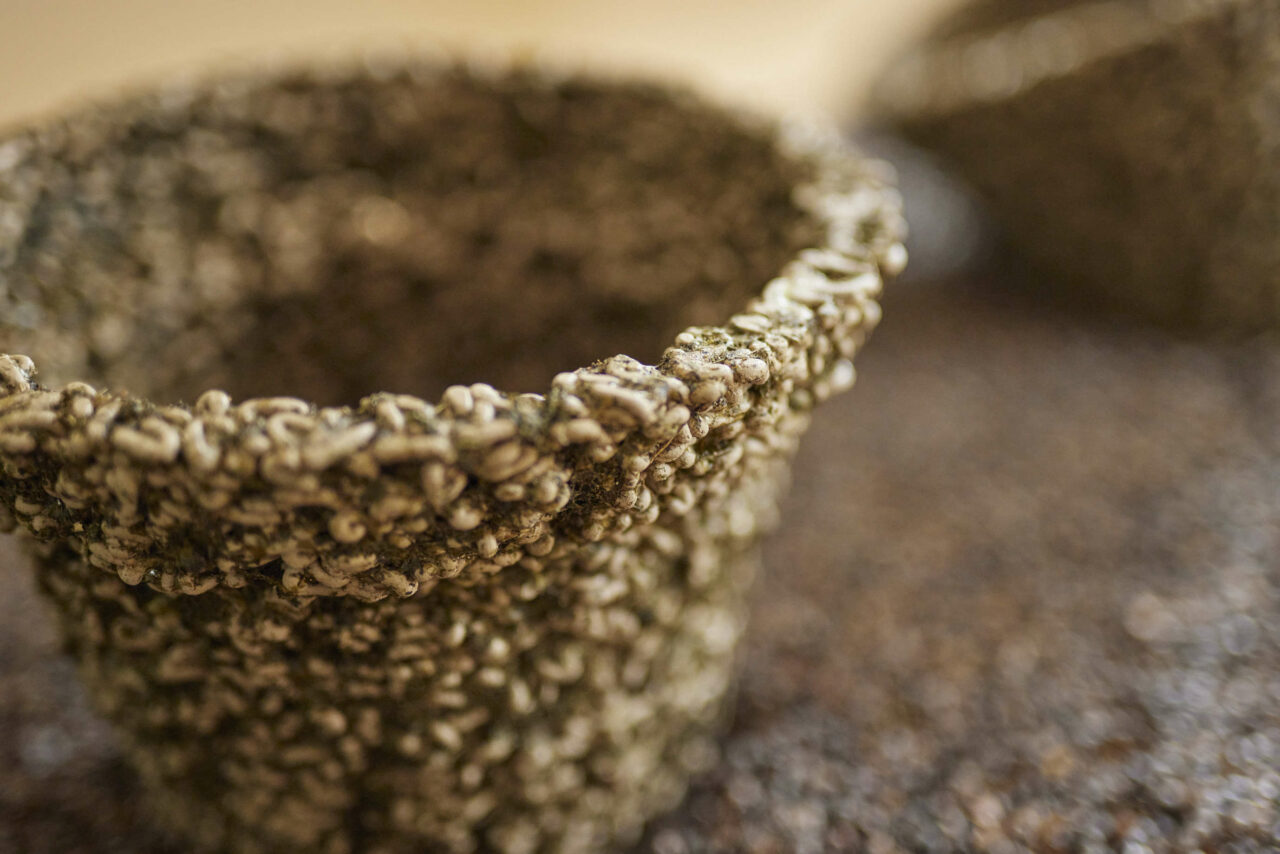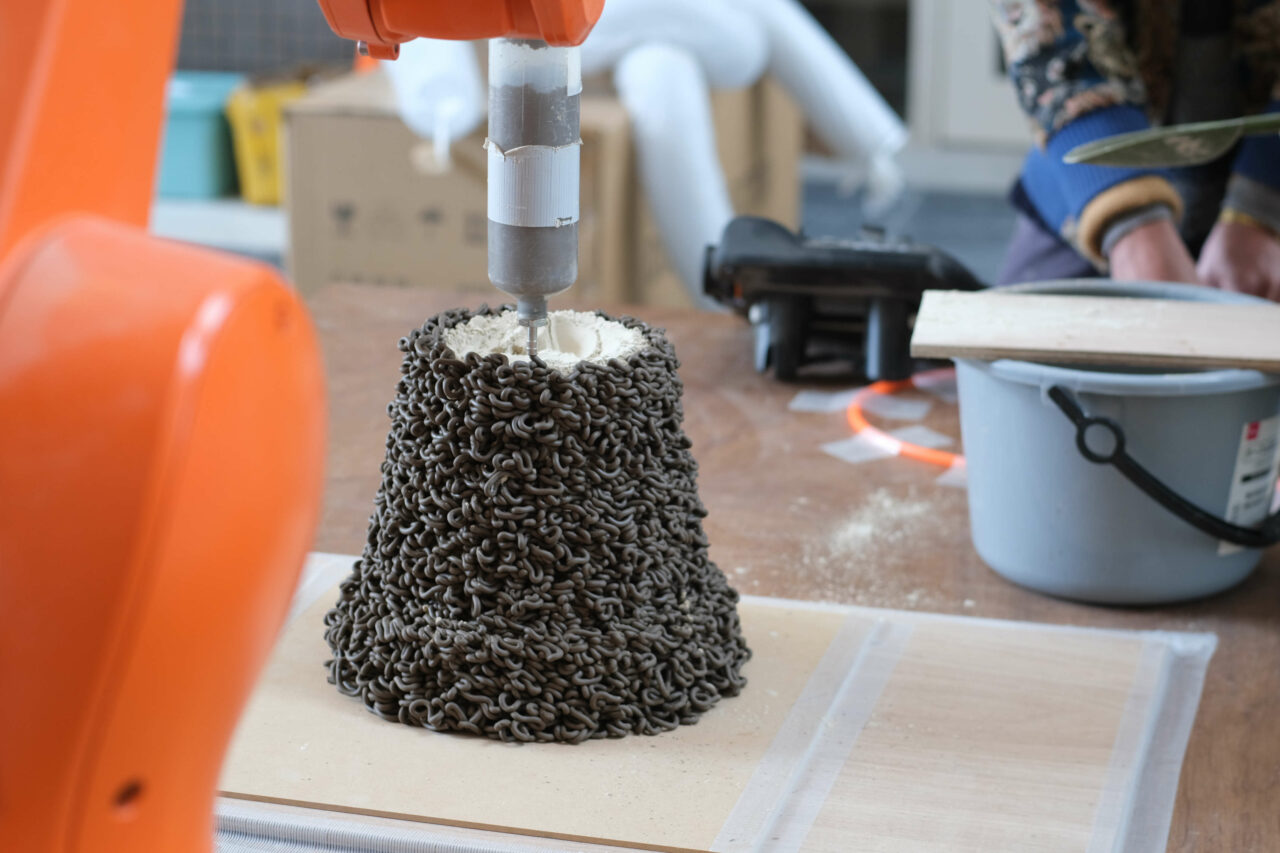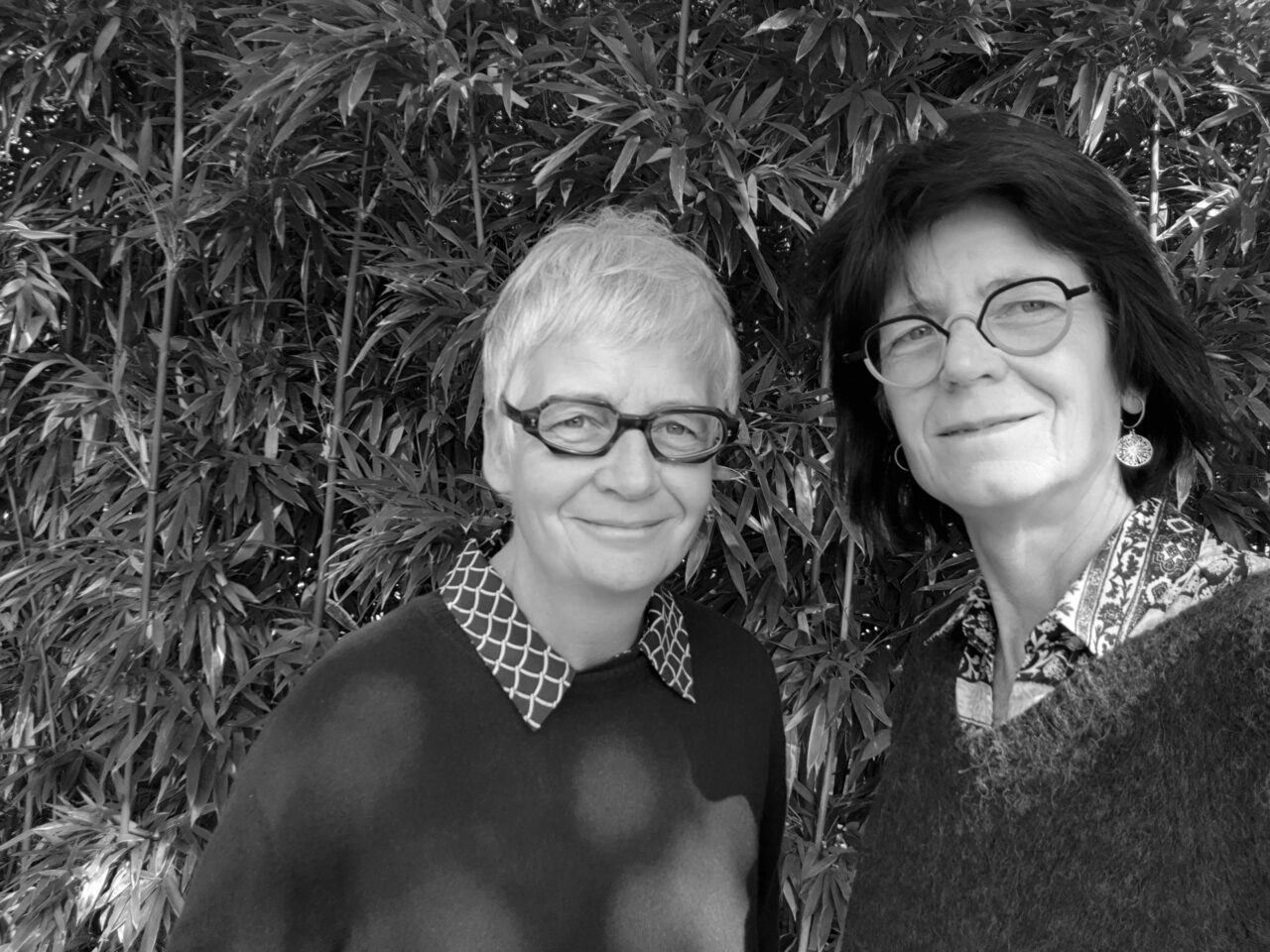2024年4月9日から13日まで、ベルギー・ブリュッセルで開催されるニュー・ヨーロピアン・バウハウス・フェスティバルにおいて、KYOTO Design Labで制作された「Photosynthesising Flowerpots」のプロトタイプが展示されます。
このプロトタイプは、ベルギーのアーティストデュオLarbitsSistersとバルナ・ゲルゲイ・ペーター特任研究員、津田和俊准教授らの2023年夏の共同制作によるものであり、KYOTO Design LabにおいてKUKAロボットアームによる粘土3Dプリンティングや光合成微生物の顕微鏡観察などの実験がおこなわれました。

© Photo credits TAKAHASHI Kenji – Photo courtesy of Tokyo Arts and Space
作品概要
「Photosynthesising Flowerpots」は、コンピュータ生成の3Dプリントされた粘土体と光合成微生物との奇妙な共生によってつくられる実験作品です。
多孔質の粘土の植木鉢と光合成シアノバクテリアが一緒に成長して工芸品を形成します。植木鉢の構造が光合成微生物をサポートまたはホストし、太陽光、土壌、水分、空気を供給する一方で、微生物はバイオミネラリゼーションを通じて植木鉢本体を強化します。この実験作品は、光合成バクテリアと植木鉢本体との共生を実現することを目指しています。

「Photosynthesising Flowerpots」は、気候変動の文脈で必要とされる、よりサステナブルなプロセスを探求します。このプロジェクトは、人間による自然の家畜化によって脅かされ、バランスが崩れている都市部に生息する多様な生態系の回復(レジリエンス)を追求しています。人間を環境からますます切り離すようになったテクノロジーを、人間とその周囲の環境との調和を可能にするプロセスによって問い直しています。
この作品は、人間の工芸品と環境を共生的な関係に結びつけます。何千年ものあいだ、人類の文明を象徴する工芸品は、芸術と火の支配を通じて人間を自然から遠ざけてきましたが、この作品は再び生物との相互関係を取り戻そうとしています。何千年にもわたる人間の職人技はそうして再利用され、形を変えて、修復されていくでしょう。生物界と同じように、植木鉢もその土地の気象条件によって、ひとつひとつ微妙に異なる形でつくられます。
会期|2024年4月9日-13日
会場|サンカントネール博物館(ベルギー・ブリュッセル)、オンライン
入場|無料

LarbitsSisters(ラービッツシスターズ)
ベルギー出身のソーシャルメディア研究者のベネディクト・ジャコブと、メディア・アーティストのロール゠アンヌ・ジャコブにより2010年に結成されたアーティスト・デュオ。新しいデジタル・メディアに対して共通の魅力を感じたことから二人で共同制作を開始。ブリュッセルを拠点とする二人の活動は、アート、テクノロジー、社会問題、エコロジーの交差する領域で展開されている。二人の作品はこれまで様々な国際展やシンポジウムで発表されており、「アルス・エレクトロニカ」ゴールデン・ニカ賞(グランプリ)など数々の賞を受賞している。
プロジェクト・マネジメント|花岡美緒
ロボットアーム・プログラミング&デジタル・マニュファクチャリング|Gergely Péter Barna
インキュベータデザイン・開発|Thomas Ortiz, Gergely Péter Barna
デジタル・ビジュアライゼーション|Jonas Stappers
バイオマテリアル、顕微鏡観察|津田和俊
サポート|吉田拓海、西村穏
From 9 to 13 April 2024, prototypes of Photosynthesising Flowerpots manufactured at KYOTO Design Lab will be on display during the exhibition of the New European Bauhaus Festival in Brussels.
The prototypes are the outcome of a collaboration between artist duo LarbitsSisters (Belgium), project researcher Gergely Péter Barna, associate professor Kazutoshi Tsuda and others, which took place during the summer of 2023.
During their stay at KYOTO Design Lab, they have conducted experimental research seeking to forge a symbiosis between a 3D clay-printing robotic arm and cyanobacteria microorganisms. Extrusion techniques and printing processes and strategies for 3D clay printing were investigated with KYOTO Design Lab. Focus was mainly on experimental research, hands-on experiments and on 3D printing with the KUKA robotic arm.

© Photo credits TAKAHASHI Kenji – Photo courtesy of Tokyo Arts and Space
Brief outline
Photosynthesising Flowerpots is an experimental work that features a flowerpot that photosynthesises crafted out of an uncanny symbiosis between a computer-generated 3D printed clay body and photosynthetic microorganisms.
A porous clay pot and photosynthetic cyanobacteria grow in tandem to form an artefact. While the pot structure supports or hosts photosynthetic microorganisms and feeds them with sunlight, soil, moisture and air, the microorganisms strengthen the body of the flowerpot through biomineralisation. The experimental work aims to achieve a symbiosis between photosynthetic bacteria, and the body of the flowerpot.

Photosynthesising Flowerpots searches for more sustainable processes so necessary in the context of climate change. The project strives for resilience among diverse ecosystems inhabiting an urban area, threatened, and unbalanced by human-induced domestication of nature. Technologies with their associated techniques and methodologies that increasingly separated man from his living environment are being challenged by processes that enable convergence between humans and their surroundings.
The work brings human artefacts and the living environment together in a symbiotic relationship. The crafts that have symbolised thousands of years of human civilisation, drawing man away from nature through art and the mastery of fire, are brought back to a reciprocal relationship with the living. Thousands of years of human craftsmanship are thus repurposed, reshaped, restored. And as in the living world, each flowerpot is manufactured slightly differently from the next, depending on the local weather conditions of the place where it is to be found.
Schedule | 09-13 April 2024
Venue | Arts & History Museum, Parc du Cinquantenaire 10, Brussels, Belgium
Fee | Free
Official website
https://new-european-bauhaus.europa.eu/festival_en

LarbitsSisters
Since 2010 social media researcher Bénédicte Jacobs (BE) and media artist Laure-Anne Jacobs (BE) form the artist duo LarbitsSisters. The work of the Brussels-based duo is situated at the crossroads of art, technology, societal questions and ecology. Their collaboration grew out of a shared fascination for the creative drives and patterns in digital media and the friction between an unbridled faith in technological progress and everyday life. In 2011 they together founded Larbitslab that has become the breeding ground for international collaborations between art and science, resulting in social critical installations, performances and events. Gradually questions regarding the use of energy resources, related wealth inequalities, and ecology have come to the fore in their work, as an urgent topic in need of disruptive visions and speculative solutions.
The specificity of Larbitslab lies in the methodological approach, which combines observing practices, profound technological explorations and application to current societal questions in a networked society increasingly in need of new relations to ecosystems it is so complexly intertwined with.
Their work has been presented in several national and international exhibitions, festivals and symposia amongst other, Imal (Brussels), BOZAR (Brussels), Ars Electronica (Linz), McaM (Shanghai), Kellen Gallery (New-York), ISEA 2020 (Montreal), Elektra 2021 (Montréal – Brussels), TOKAS Arts and Space (Tokyo). Comprising social media researcher Bénédicte Jacobs and media artist Laure-Anne Jacobs, LarbitsSisters has won the NOVA New Media Interactive Art Prize, the Prix Ars Electronica Golden Nica and the NTAA New Technological Art Award. The duo was selected for various international residency programs.
Project management | Mio Hanaoka
Robotic arm programming and digital manufacturing | Gergely Péter Barna
Incubator design and development | Thomas Ortiz, Gergely Péter Barna
Digital Visualisation | Jonas Stappers
Biomaterials and microscopy | Kazutoshi Tsuda
Archiving support | Takumi Yoshida, Yasuki Nishimura